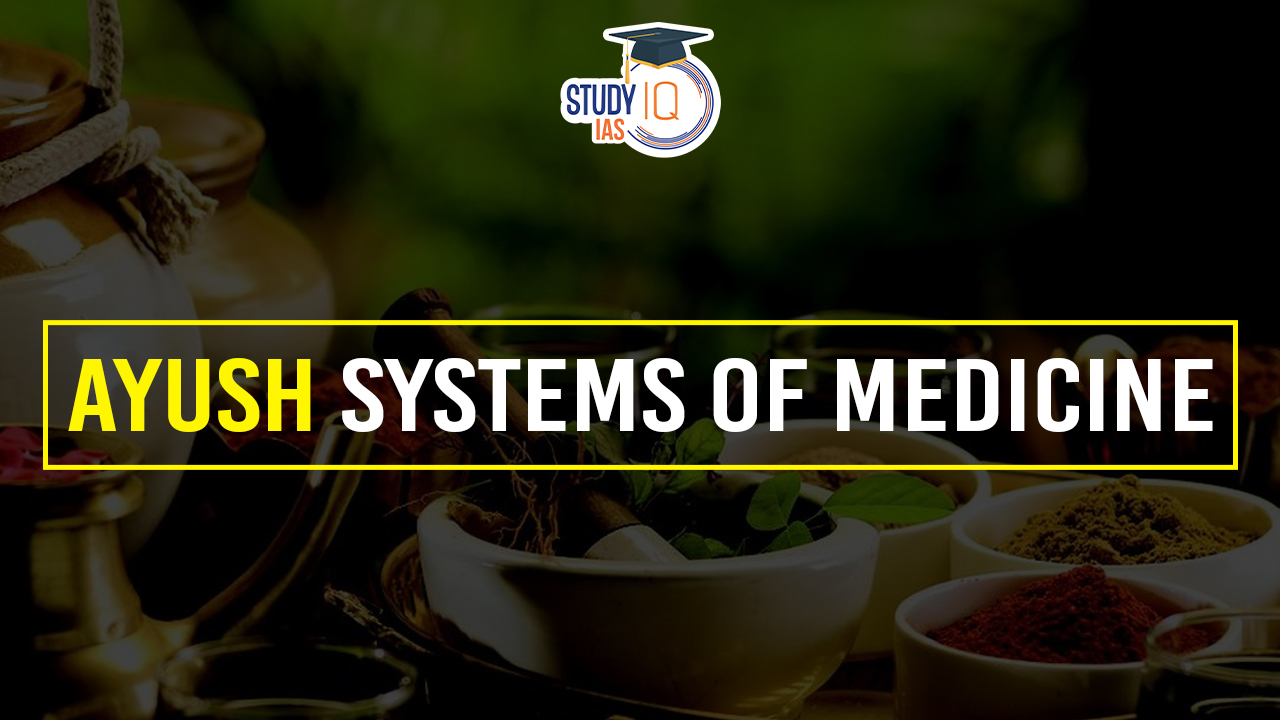Table of Contents
AYUSH is an acronym for Ayurveda, Yoga & Naturopathy, Unani, Siddha, Sowa Rigpa, and Homoeopathy. The Ministry of AYUSH Government Schemes was introduced in 2014. The healthcare practices advocated by Ayush systems are known to promote general wellness. They exert a positive impact both on the mind and the body.
AYUSH Systems of Medicine
The AYUSH systems of medicine represent a diverse array of traditional healing practices that have evolved over centuries in India. Each system has its unique philosophy, principles, diagnostic methods, and treatment modalities. Here’s a detailed overview of each:
We’re now on WhatsApp. Click to Join
| System | Origins and Philosophy | Principles | Diagnostic Methods | Treatment Modalities |
| Ayurveda | Originated over 5,000 years ago in ancient India; based on the balance between mind, body, and spirit | Emphasizes doshas (bioenergetic forces) – Vata, Pitta, Kapha; each individual is unique | Pulse examination, observation, detailed questioning about lifestyle and habits | Lifestyle modifications, dietary changes, herbal remedies, detoxification therapies (Panchakarma), yoga, meditation, massage (Abhyanga) |
| Yoga & Naturopathy | Yoga: Ancient Indian practice encompassing physical postures, breathing techniques, meditation; Naturopathy: Body’s inherent ability to heal using natural remedies and lifestyle changes | Integration of mind, body, spirit in yoga; identification of root causes, prevention, and support of natural healing processes in naturopathy | Personalized practices – asanas, pranayama, meditation, relaxation techniques; dietary changes, herbal medicine, hydrotherapy, fasting, lifestyle counseling | |
| Unani | Originated in ancient Greece, further developed in medieval Islamic world; based on balance of bodily humors | Views health as equilibrium of bodily humors; imbalances lead to illness | Observation, pulse examination, detailed history-taking | Herbal remedies, dietary interventions, cupping (Hijama), lifestyle modifications |
| Siddha | Originated in ancient Tamil Nadu, India; influenced by Ayurveda and Tamil culture; balance of five elements and three doshas | Health as equilibrium of elements and doshas; imbalances due to lifestyle, environmental factors | Pulse examination, observation, detailed history-taking | Herbal remedies, mineral preparations, dietary modifications, yoga, meditation, lifestyle counseling |
| Homeopathy | Founded by Samuel Hahnemann in late 18th century Germany; “like cures like” principle | Health as balance within body’s vital force; illness due to disruptions in vital force | Detailed interviews, case-taking | Individualized remedies from natural substances, highly diluted to stimulate self-healing mechanisms |
Ayurveda
-
- Origins and Philosophy: Ayurveda, which means “the science of life” in Sanskrit, originated in ancient India over 5,000 years ago. It is based on the belief that health and wellness depend on a delicate balance between the mind, body, and spirit.
- Principles: Ayurveda recognizes that each individual is unique and emphasizes the concept of “doshas” (bioenergetic forces) – Vata (air and ether), Pitta (fire and water), and Kapha (water and earth). Imbalances in these doshas are believed to lead to illness.
- Diagnostic Methods: Ayurvedic practitioners use various diagnostic techniques, including pulse examination (Nadi Pariksha), observation, and detailed questioning about lifestyle, diet, and habits.
- Treatment Modalities: Treatment in Ayurveda focuses on restoring balance through lifestyle modifications, dietary changes, herbal remedies, detoxification therapies (such as Panchakarma), yoga, meditation, and massage (Abhyanga).
Yoga and Naturopathy
-
- Origins and Philosophy: Yoga originated in ancient India and encompasses physical postures (asanas), breathing techniques (pranayama), meditation, and ethical principles to achieve holistic well-being. Naturopathy is based on the belief in the body’s inherent ability to heal itself using natural remedies and lifestyle modifications.
- Principles: Yoga emphasizes the integration of mind, body, and spirit, promoting balance and harmony. Naturopathy focuses on identifying and addressing the root causes of illness, emphasizing prevention and supporting the body’s natural healing processes.
- Treatment Modalities: Yoga therapy involves personalized practices tailored to individual needs, including asanas, pranayama, meditation, and relaxation techniques. Naturopathic treatments may include dietary changes, herbal medicine, hydrotherapy, fasting, and lifestyle counseling.
Unani
-
- Origins and Philosophy: Unani medicine, also known as Greco-Arabic medicine, traces its origins to ancient Greece and was further developed in the medieval Islamic world. It is based on the principles of the four humors (blood, phlegm, yellow bile, black bile) and the balance of bodily fluids.
- Principles: Unani medicine views health as a state of equilibrium between the body’s humors. Illness is believed to result from imbalances in these humors, environmental factors, and lifestyle habits.
- Diagnostic Methods: Unani practitioners diagnose patients through observation, pulse examination, and detailed history-taking, focusing on the patient’s temperament and constitution.
- Treatment Modalities: Treatment in Unani medicine includes herbal remedies, dietary interventions, detoxification therapies, cupping (Hijama), and lifestyle modifications.
Siddha
-
- Origins and Philosophy: Siddha medicine originated in ancient Tamil Nadu, India, and is influenced by the principles of Ayurveda and Tamil culture. It emphasizes the balance of five elements (earth, water, fire, air, ether) and three doshas (Vata, Pitta, Kapha).
- Principles: Siddha medicine views health as a state of equilibrium between the body’s elements and doshas. Illness is believed to result from imbalances in these factors, lifestyle factors, and environmental influences.
- Diagnostic Methods: Siddha practitioners diagnose patients through pulse examination, observation, and detailed history-taking, considering the patient’s physical, mental, and spiritual aspects.
- Treatment Modalities: Treatment in Siddha medicine includes herbal remedies, mineral preparations, dietary modifications, yoga, meditation, and lifestyle counseling.
Homeopathy
-
- Origins and Philosophy: Homeopathy was founded in the late 18th century by Samuel Hahnemann in Germany. It is based on the principle of “like cures like,” where substances that cause symptoms in healthy individuals are diluted and used to treat similar symptoms in sick individuals.
- Principles: Homeopathy views health as a state of balance and harmony within the body’s vital force or energy. Illness is believed to result from disruptions in this vital force, which manifests as symptoms.
- Diagnostic Methods: Homeopathic practitioners conduct detailed interviews and case-taking to understand the patient’s symptoms, temperament, and constitution.
- Treatment Modalities: Treatment in homeopathy involves individualized remedies prepared from natural substances, which are highly diluted to stimulate the body’s self-healing mechanisms.
Basic Principles of AYUSH
- Ayurveda’s Concept of Life (Ayu): Ayurveda sees life as the union of the physical body, sense organs, mind, and soul. It aims to promote health and benefit society.
- Components of Health: Ayurveda defines a healthy person as one whose dosha (metaphysiological entities), agni (metabolic fire), dhatus (tissues), malas (excretory products), soul (atma), sense organs (indriya), and mind (manas) are balanced.
- Dosha: Three doshas – Vata, Pitta, and Kapha – govern every living thing and control temperament, personality, health, and diseases. Imbalance leads to pathogenesis.
- Vata: Governs movement, sensation, speech, circulation, breathing, and excretion.
- Pitta: Responsible for digestion, metabolism, intellect, absorption, assimilation, and regulation of heat.
- Kapha: Provides structure, lubrication, stability, strength, vigour, immunity, and cohesion to the body.
- Mansik Dosha: Mental disorders are attributed to two doshas – Rajas and Tamas.
- Dhatu: Seven nourishing and structural elements (Rasa, Rakta, Mamsa, Meda, Asthi, Majja, Shukra) form the body and constantly undergo formation, destruction, and reformation.
- Mala: Waste products of dhatus except Shukra Dhatu, considered poisonous if retained in the body.
- Pancha-Mahabhuta: Everything in the universe, including humans, is composed of five basic elements – Akasa (Space), Vayu (Air), Teja/Agni (Fire), Jala (Water), and Prithvi (Earth), each with distinct attributes and roles.
- Interrelationship: The dynamic interaction of these elements maintains the balance in the body and the universe, influencing bodily functions and structures.
National AYUSH Mission (NAM)
| Scheme Name | National AYUSH Mission (NAM) |
| Objective | Promotion of AYUSH medical systems through cost-effective services, strengthening of educational systems, and quality control of ASU & H drugs |
| Approval Date (Original) | 29th September 2014 |
| Continuation Approval Dates | 15th December 2017 (01.04.2017 – 31.03.2020), 14th July 2021 (01.04.2021 – 31.03.2026) |
| Financial Implication | Rs. 4607.30 crores (Rs. 3000.00 Crore Central Share, Rs. 1607.30 crores State Share) |
| AHWC Component Financial Outlay | Rs. 3399.35 Crores for 5 years (upto 2023-24) |
| Component Excluded from NAM Continuation | AYUSH Health and Wellness Centres (AHWCs) |
| Operationalization of AHWCs | Implemented through National AYUSH Mission |
| Implementation Period | 01.04.2021 – 31.03.2026 |
| Expected Impact | Enhanced outreach in planning, supervision, and monitoring of AYUSH schemes |


 Asia’s Largest Tulip Garden
Asia’s Largest Tulip Garden
 World Happiness Report 2025, India's Ran...
World Happiness Report 2025, India's Ran...
 World Water Day 2025, Date, Theme, Histo...
World Water Day 2025, Date, Theme, Histo...





















